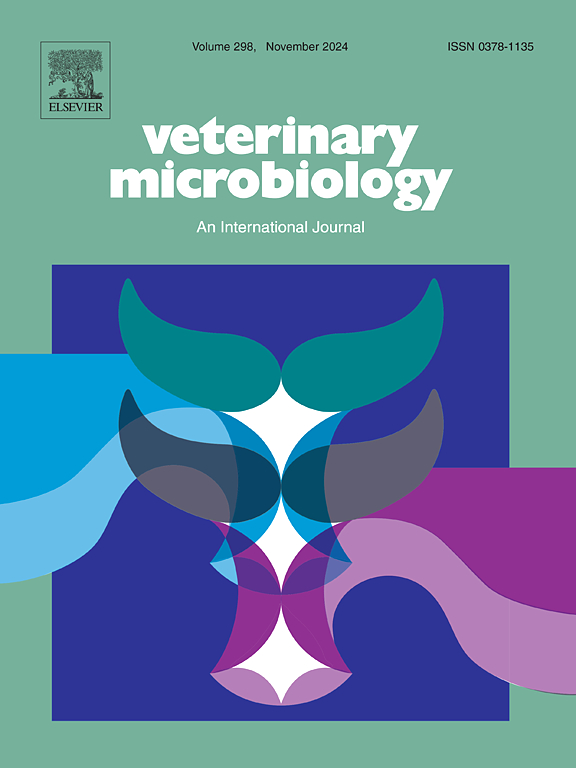Core genome multilocus sequence typing schemes for epidemiological investigation of Taylorella equigenitalis and Taylorella asinigenitalis
IF 2.4
2区 农林科学
Q3 MICROBIOLOGY
引用次数: 0
Abstract
Taylorella equigenitalis is the causative agent of contagious equine metritis, an internationally regulated sexually-transmitted infection in horses, which is of great concern as it usually results in temporary infertility. Taylorella asinigenitalis, the second member of the genus, is mainly found in donkeys and is considered non-pathogenic, although a first natural outbreak was reported in 2019 in the United Arab Emirates. Multilocus sequence typing (MLST) is currently used to study the epidemiology of Taylorella spp. but, while highly transposable and reproducible, it only focuses on < 0.5 % of the genome (seven genes). We therefore aimed to develop a robust core genome MLST (cgMLST) based on the analysis of 370 T. equigenitalis and 68 T. asinigenitalis genomes belonging to 46 and 18 sequence types (STs), respectively. Typing results based on 1333 loci (84.0 % of the genome) from T. equigenitalis genomes and 1255 loci (80.3 %) from T. asinigenitalis genomes showed that the discriminatory power of both species-specific cgMLSTs was greater than that of MLST, with 368 and 68 distinct core genome STs (cgSTs), respectively. Clustering was congruent between the cgMLST and MLST methods, with few inconsistencies for T. equigenitalis. Maximum allelic distance between epidemiologically-related strains was used to define cgMLST clustering thresholds, set at ≤ 15 and 20 allelic distances for T. equigenitalis and T. asinigenitalis, respectively. These parameters grouped the cgSTs into 47 and 11 clonal groups (CGs), respectively. Overall, the cgMLST method outperformed conventional MLST in distinguishing clonal strains from epidemiologically-linked strains, supporting the hypothesis that typing based on a few housekeeping genes does not always accurately reflect genomic relatedness between strains, and making cgMLST more suitable for outbreak investigations.
等长泰勒菌和亚洲原始泰勒菌流行病学调查的核心基因组多位点序列分型方案
马乳头状芽孢杆菌是传染性马子宫炎的病原体,这是一种国际规范的马性传播感染,由于它通常导致暂时不孕,因此引起高度关注。Taylorella asinigenitalis是该属的第二个成员,主要存在于驴中,被认为是非致病性的,尽管2019年在阿拉伯联合酋长国报告了第一次自然爆发。多位点序列分型(Multilocus sequence typing, MLST)目前用于研究泰勒菌的流行病学,但是,虽然它具有高度的转座性和可重复性,但它只关注<; 0.5 %的基因组(7个基因)。因此,我们的目标是基于370 T的分析开发一个健壮的核心基因组MLST (cgMLST)。equigenitalis和68 T。asinigenitalis基因组分别属于46个和18个序列类型(STs)。结果表明,分别有1333个(84.0 %)和1255个(80.3 %)的核心基因组STs (cgMLSTs)的区分能力均大于MLST,分别有368个和68个核心基因组STs (cgSTs)。cgMLST方法与MLST方法聚类一致,对马齿苋的聚类不一致。采用流行病学相关菌株之间的最大等位基因距离定义cgMLST聚类阈值,equigenitalis和asinigenitalis分别设置为≤ 15和20等位基因距离。这些参数将cgSTs分别分为47个和11个克隆群(CGs)。总体而言,cgMLST方法在区分克隆菌株和流行病学相关菌株方面优于传统的MLST方法,这支持了基于少数内控基因的分型并不总是准确反映菌株之间基因组相关性的假设,并使cgMLST更适合于疫情调查。
本文章由计算机程序翻译,如有差异,请以英文原文为准。
求助全文
约1分钟内获得全文
求助全文
来源期刊

Veterinary microbiology
农林科学-兽医学
CiteScore
5.90
自引率
6.10%
发文量
221
审稿时长
52 days
期刊介绍:
Veterinary Microbiology is concerned with microbial (bacterial, fungal, viral) diseases of domesticated vertebrate animals (livestock, companion animals, fur-bearing animals, game, poultry, fish) that supply food, other useful products or companionship. In addition, Microbial diseases of wild animals living in captivity, or as members of the feral fauna will also be considered if the infections are of interest because of their interrelation with humans (zoonoses) and/or domestic animals. Studies of antimicrobial resistance are also included, provided that the results represent a substantial advance in knowledge. Authors are strongly encouraged to read - prior to submission - the Editorials (''Scope or cope'' and ''Scope or cope II'') published previously in the journal. The Editors reserve the right to suggest submission to another journal for those papers which they feel would be more appropriate for consideration by that journal.
Original research papers of high quality and novelty on aspects of control, host response, molecular biology, pathogenesis, prevention, and treatment of microbial diseases of animals are published. Papers dealing primarily with immunology, epidemiology, molecular biology and antiviral or microbial agents will only be considered if they demonstrate a clear impact on a disease. Papers focusing solely on diagnostic techniques (such as another PCR protocol or ELISA) will not be published - focus should be on a microorganism and not on a particular technique. Papers only reporting microbial sequences, transcriptomics data, or proteomics data will not be considered unless the results represent a substantial advance in knowledge.
Drug trial papers will be considered if they have general application or significance. Papers on the identification of microorganisms will also be considered, but detailed taxonomic studies do not fall within the scope of the journal. Case reports will not be published, unless they have general application or contain novel aspects. Papers of geographically limited interest, which repeat what had been established elsewhere will not be considered. The readership of the journal is global.
 求助内容:
求助内容: 应助结果提醒方式:
应助结果提醒方式:


